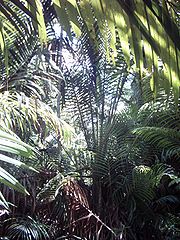Sago is a starch extracted from the pith of sago palm stems,

Pearl sago, a commercial product, closely resembles pearl tapioca. Both typically are small (about 2 mm diameter) dry, opaque balls. Both may be white (if very pure) or colored naturally grey, brown or black, or artificially pink, yellow, green, etc. When soaked and cooked, both become much larger, translucent, soft and spongy. Both are widely used in South Asian cuisine, in a variety of dishes, and around the world, usually in puddings. In India, pearl sago is called javvarisi, or sabudana ("whole grain") and is used in a variety of dishes such as desserts boiled with sweetened milk on occasion of religious fasts.
Sago looks like many other starches, and both sago and tapioca are produced commercially in the form of "pearls". Sago pearls are similar in appearance to tapioca pearls, and the two may be used interchangeably in some dishes. This similarity causes some confusion in the names of dishes made with the pearls.
http://en.wikipedia.org/wiki/Sago
It is a major staple food for the lowland peoples of New Guinea and the Moluccas, where it is called saksak and sagu. It is traditionally cooked and eaten in various forms, such as rolled into balls, mixed with boiling water to form a paste, or as a pancake.
Because sago flour made from Metroxylon is the most widely used form, this article discusses sago from Metroxylon unless otherwise specified.Sago starch is either baked (resulting in a product analogous to bread or a pancake) or mixed with boiling water to form a paste. Sago can be made into steamed puddings such as sago plum pudding, ground into a powder and used as a thickener for other dishes, or used as a dense glutinous flour.[citation needed]
Sago flour (from Metroxylon) is nearly pure carbohydrate and has very little protein, vitamins, or minerals. However, as sago palms are typically found in areas unsuited for other forms of agriculture, sago cultivation is often the most ecologically appropriate form of land-use, and the nutritional deficiencies of the food can often be compensated for with other readily available foods.
One hundred grams of dry sago yields 355 calories, including an average of 94 grams of carbohydrate, 0.2 grams of protein, 0.5 grams of dietary fiber, 10 mg of calcium, 1.2 mg of iron, and negligible amounts of fat, carotene, thiamine, and ascorbic acid.
In Indonesia and Malaysia, sago is used in making noodles and white bread. Globally, its principal use is in the form of pearls. In Brunei, it is used for making the popular local cuisine called the Ambuyat.
Netroxylon sago is made through the following process:
- The sago palm is felled.
- The trunk is split lengthwise and the pith is removed.
- The pith is crushed and kneaded to release the starch.
- The pith is washed and strained to extract the starch from the fibrous residue.
- The raw starch suspension is collected in a settling container.
Palms are felled just before flowering, when the stems are richest in starch. One palm yields 150 to 300 kg of starch.
Sago can be stored for weeks or months, although it is generally eaten soon after it is processed.
The starch is also used to treat fibre, making it easier to machine. This process is called sizing and helps to bind the fibre, give it a predictable slip for running on metal, standardise the level of hydration of the fibre, and give the textile more body. Most cloth and clothing has been sized; this leaves a residue which is removed in the first wash.
The sago palm, Metroxylon sagu, is found in tropical lowland forest and freshwater swamps across Southeast Asia and New Guinea and is the primary source of sago flour. It tolerates a wide variety of soils and may reach 30 meters in height. The palm genus Metroxylon contains several species: two of these, M. salomonense and M. amicarum, are less-important sources of sago in Melanesia and Micronesia.
Sago palms grow very quickly, up to 1.5m of vertical stem growth per year. The stems are thick and either are self-supporting or have a moderate climbing habit. The leaves are pinnate, not palmate. The palms will only reproduce once before dying; they are harvested at the age of 7 to 15 years, just before flowering, when the stems are full of starch stored for use in reproduction.
In addition to its use as a food source, the leaves and spathe of the sago palm are used for construction materials and for thatching roofs. The fibre can be made into rope.
| < Prev | Next > |
|---|
















